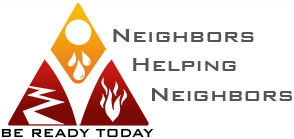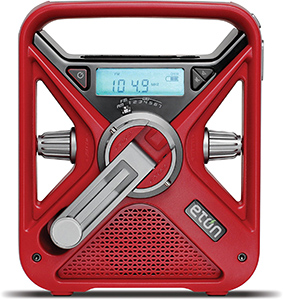There are two main times when emergency information is important.
When there is no emergency, it is important to get information about how to prepare for emergencies. When disaster strikes, it is important to get clear information about what you need to know to survive, even if power and other services fail.
Get the PDF version of our Stay Informed handout... 
The best source of emergency preparedness information in normal times is here, the WPV-Ready program.
 This website provides guidance on the basics of preparedness, as well as help in organizing your local Ready Community. You can find out who your local Community Leaders are on the Find My Leaders page. If you don't already have an organized community where you live, start one! We make it easy.
This website provides guidance on the basics of preparedness, as well as help in organizing your local Ready Community. You can find out who your local Community Leaders are on the Find My Leaders page. If you don't already have an organized community where you live, start one! We make it easy.
You can connect to the WPV-Ready social resources using the links at the bottom of any page. You will also find links for Zonehaven's evacuation zone tool, and SMC Alert, our primary method of sending emergency alerts to residents in the district.
After a major earthquake, there may be few or no transmitters operating, including cell systems and internet connections. In this case, you don't really need an alert; you already know there was an earthquake.
For events like wildfire or severe storm, one of the emergency alert systems may be your best way of getting timely notice that it's time to evacuate or find shelter. In our area, the first and best way to get these alerts is the SMC Alert system. Learn more, and sign up, in the section below.
There are a number of broader alert systems. All public transmitters, radio and television, are required to carry certain alerts. In a large-scale emergency, certain radio stations become highly-reliable, full-time emergency information broadcasters, including AM stations KGO 810, KCBS 740, and KNBR 680, and FM stations KQED 88.5 and KCBS 106.9. And there are systems like Wireless Emergency Alert (WEA), and the Emergency Alert System (EAS) created by the FCC. Each of these is described in more detail below.
Once an emergency incident begins, it is also important to have sources of more detailed information. In your neighborhood, you can create a bulletin board system to post status updates, requests for service, locations of other services and so forth. Public broadcasters will transmit similar information for the whole area. And our WPV-CERT team will provide information for our fire district.
Let's take a look at the important resources for our area.
SMCAlert - The Primary Source for Alerts in Our District
SMCAlert lets you sign up for email, text message and telephone alerts. It is the primary source for alerts from our local agencies. You can sign up for emergency alerts, road closures and a variety of other alerts. If you are not signed up yet, please visit http://smcalert.info now. It is the very best first step you can take to improve your own preparedness.
Get our SMCAlert PDF... 
 If an order to evacuate is ever given that impacts you, you will hear about it first on SMCAlert. You should be absolutely sure that you are subscribed now. And you should check your subscription once or twice every year. Check now!
If an order to evacuate is ever given that impacts you, you will hear about it first on SMCAlert. You should be absolutely sure that you are subscribed now. And you should check your subscription once or twice every year. Check now!
Zonehaven Helps Us Evacuate
 The Zonehaven system will also show the status of evacuation warnings and orders on their map. So if you are unsure about when a warning was given, or what the status of your Zone is, you can see it on the map. If you do not know your Zone, please use their "Find My Zone" tool to check it now, and write it down.
The Zonehaven system will also show the status of evacuation warnings and orders on their map. So if you are unsure about when a warning was given, or what the status of your Zone is, you can see it on the map. If you do not know your Zone, please use their "Find My Zone" tool to check it now, and write it down.
Federal Emergency Alert Systems
The federal government has created several emergency alert systems over recent decades. They have each evolved in various ways. Each has its own benefits and drawbacks. In 2006 they started building IPAWS (details below) to bring these systems together, coordinate and standardize our national alert system. Let's look at the parts of this system. Clicking on the names below will take you to a Wikipedia page that gives a fairly detailed and accurate description of the history and operation of these systems.
IPAWS - The Integrated Public Alert and Warning System unifies the Emergency Alert System (EAS), National Warning System (NAWAS), Wireless Emergency Alerts (WEA), and NOAA Weather Radio (NWR), under a single platform.
EAS - The Emergency Alert System was originally designed to allow the President to send an alert to the entire nation within 10 minutes. It has evolved into a more flexible system able to send more localized alerts. It depends primarily on radio and television broadcasters to carry alerts. All broadcasters are required to participate in EAS.
WEA - The Wireless Emergency System was designed to send alerts to mobile devices. Modern cell phones have WEA alerts built in, and difficult or impossible to turn off.
NAWAS - The National Warning System uses telephone landlines to send alerts.
NWR - The NOAA Weather Radio system is a 24-hour network of VHF radio transmitters throughout the USA, broadcasting weather information and emergency alerts.
As smart devices become more present in our lives, many are now required to have emergency alert systems built in. Your new Smart TV, for instance, will now display emergency alerts just like your cell phone.
NOAA Alert Radios
 NOAA is a federal agency that broadcasts continuous weather and alert information throughout the USA. In our district, there are 4 transmitters that (in theory) transmit toward us. Your coverage may vary a lot. When there is a large-scale alert, NOAA broadcasts those too. You can get severe storm and wind, red flag warnings, even tsunamis (useful if you have a boat).
NOAA is a federal agency that broadcasts continuous weather and alert information throughout the USA. In our district, there are 4 transmitters that (in theory) transmit toward us. Your coverage may vary a lot. When there is a large-scale alert, NOAA broadcasts those too. You can get severe storm and wind, red flag warnings, even tsunamis (useful if you have a boat).
We have had good success in our district with a radio you can get from Amazon, the Midland WR-120. Our PDF, which you can get below, has some useful information for programming this or any other NOAA alert radio. This is not a product endorsement, just the personal experience of several volunteers. But we will help you find it on Amazon...
Click here to see the PDF... 
Portola Valley Emergency AM Radio, AM-1680
Portola Valley operates a low-power AM radio station, broadcasting information on AM-1680. In a large-scale emergency, you will be able to tune to this station for fresh information. Coverage is limited. So unless you are strictly within Portola Valley, you might get nothing.
PG&E Public Safety Power Shutoffs (PSPS)
 Our power company sometimes shuts off power in an area to avoid teh risk of fire ignition from damaged power lines. You can find out about current power outages and planned PSPS events on PG&E's Outages map.
Our power company sometimes shuts off power in an area to avoid teh risk of fire ignition from damaged power lines. You can find out about current power outages and planned PSPS events on PG&E's Outages map.
Emergency AM/FM Radio
 When power is down, and you can't get any other radio or cell system to work, you can still use one of these radios to get information. They have built-in solar power and a hand crank. They can get AM, FM, and NOAA broadcasts. There are several commercial transmitters in our are that are required to broadcast emergency information if they are able. And they have big generators and extra-strong antennas. The FCC requires this, pretty much everywhere.
When power is down, and you can't get any other radio or cell system to work, you can still use one of these radios to get information. They have built-in solar power and a hand crank. They can get AM, FM, and NOAA broadcasts. There are several commercial transmitters in our are that are required to broadcast emergency information if they are able. And they have big generators and extra-strong antennas. The FCC requires this, pretty much everywhere.
This specific radio is one that several volunteers here have found to work well. This is not a product endorsement from WPV-Ready. But we will help you find it on Amazon...
Our Friends at Ready.gov Have a Great Page About Emergency Alerts
Click here to see the Emergency Alerts page at Ready.gov...
Mobile Apps are Coming On Strong
As the world continues to become more connected, we get better and better apps to tell us what is happening around us.
- PulsePoint.org: PulsePoint Respond is a 911-connected app that can immediately inform you of emergencies occurring in your community and can request your help when CPR is needed nearby.
- FireDispatch.com: Your way to track fire incidents within San Mateo County. Use the website, or listen on the app.
- MyShake.Berkeley.edu: Have earthquake information at your fingertips and see damage reports shared by citizen scientists like you.